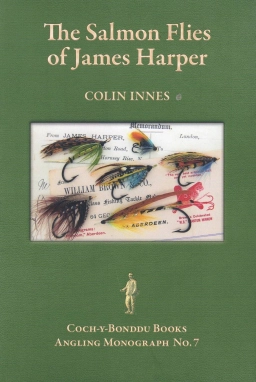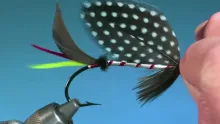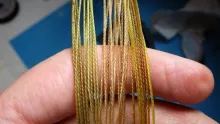Some books tend to go under the radar, but are still small gems of knowledge, history ... and fly patterns ... These books from 2016/17 have been hiding in my shelf for way too long.
Updated or edited 10 months ago
I have had these three little green books for a long time. I have read them and enjoyed them, but honestly never thought much about them after reading them. They are from 2016 and 2017, and may have been overshadowed a bit by Farlows Salmon Flies by Martin Lanigan-O'Keeffe, published in 2017. The follow up, Hardy’s Salmon Flies by the same author, published in 2019 may have removed my focus even more from Colin Innes’ three little green books.
I call them small,
because compared to the two other volumes, they are tiny, which in this case just means a normal book format; 157 x 234 mm or a little larger than 6 x 9 inches. They are paperback and 108, 124, and 278 pages respectively. I call them green because they are indeed green, being part of the series Angling Monographs published by Welsh Coch-y-Bonddu Books, characterized by the leaf green color on their covers.
They are titled
“The Lost Salmon Flies of Balmoral”, “The Salmon Flies of James Harper”, and “Ernest Crosfield” and are numbers 2, 7 and 8 in the series, which contains many other interesting titles.
They are in many ways like the above mentioned O’Keeffe titles inasmuch as they are about salmon flies (and more) from the golden era of salmon fishing in the mid to late 1800’s and the early to mid 1900’s. They are equally well researched, document their subjects really well, and are richly illustrated with pictures of vintage and newly tied flies, excerpts and covers from various printed media, and lots of original illustrations - from plates and prints to small illustrations showing patterns and tying techniques.
But they are not
(almost) endless catalogs of flies, but more “reading worthy” historic accounts of places, people and patterns, from the two people named in the titles – Ernest Harper and James Crosfield – and the castle-slash-beat Balmoral on the renowned Scottish river Dee, represented by a third name, namely John Michie.
The castle is definitely the better known of these names while the Dee is most likely known by a far majority of anglers – salmon anglers in particular. Harper, Crosfield and Michie on the other hand, are very likely as unknown to most anglers as they were to me before I read the books.
The Lost Salmon Flies of Balmoral
Angling Monograph No.2
Starting with the first
of the three if taken chronologically, the third name is introduced – John Michie – often referred to as John Michie MVO, meaning Member of the Royal Victorian Order, an order of knighthood established by Queen Victoria, given to Michie by King Edward several years after Vitoria’s death when he retired from his position as Head Forester and later Factor at Balmoral.
During his years at Balmoral, Michie wrote a series of diaries, registering the daily happenings on the castle, and – of particular interest to us as anglers – the salmon fishing on the Dee.
These diaries form the base for the book “The Lost Salmon Flies of Balmoral”, and were, as it appears in the many quotes and excerpts, quite detailed, containing short but very precise descriptions of the fishing, weather, the fish, flies, people and other aspects of being on the river.
In this book,
a large number of these entries are reprinted ad verbatim and interpreted and explained, and many name the flies used, and are followed by detailed pattern descriptions and materials lists. Many of the flies are shown in excellent color photographs – either vintage flies from the era or replications tied by Edward Kublin.
Following Michie’s daily life and reading the notes is a joyful journey back to a time where there seemed to be plenty – and good – salmon to catch, and plenty interesting people to meet, both royalty, their guests and local people.
Innes adds a lot of spice to Michie’s entries with little remarks, elaborations or explanations and then of course by describing the flies, which are the centerpieces of the book.
A great history lesson – with added, classical salmon flies. What’s not to like?
The Salmon Flies of James Harper
Proprietor of William Brown Fishing Tackle, Aberdeen, 1901-1945, Angling Monograph No.7
The next in the lot,
number 7 in the series entitled “The Salmon Flies of James Harper” introduces another character, James Harper obviously, whose legacy as the proprietor of the firm William Brown of Aberdeen has been partly preserved in the form of his records of the flies that the company produced and sold.
Colin Innes has had access to these records, and in this book – the thickest of the three – he goes through the story of how he came upon the notes and other sources, shows quite a few of the flies in the list (there are about 200) with images, materials and notes. Most of the images are of vintage flies from the author’s and other peoples’ collections (including the one of Lanigan-O’Keeffe, who is mentioned above) and a few are newly tied.
In this respect, this particular book is more like Lanigan-O'Keeffe’s books on the Farlow and Hardy flies, listing them alphabetically and offering recipes and descriptions detailed enough to allow the reader to tie them… if you can get a hold of the materials that is. There’s quite a bit of chatterer, macaw, bustard and other exotic bird names in the lists. These are flies that were tied into the mid 1900’s, and protection and Cites was not as big a concern as it is today.
Never the less the list is a feast of well known and lesser known salmon flies, all tied for fishing and with no thoughts given to display cases or shadow boxes.
The first part
of the book consists of thorough biographies of the people connected to the company and contains therein the history of the company, some of the flies and the fishing they were used for. This section is richly illustrated with photos, facsimiles of ads from newspapers and magazines as well as B/W drawings. There are also a lot of transcripts from books, magazines, newspapers and other written sources from the era. The middle part – and major part – is, as mentioned above, the flies, and the last part is appendixes with reprints of the original lists as well as color fly plates, and some notes on materials.
Again an enjoyable journey and very entertaining to read, not least the introductory part.
Ernest Crosfield
His Salmon Flies and Fishing, Angling Monograph No.8
The third book
is on Ernest Crosfield, the only name of the three that rang a small bell when I first got the book. Crosfield was an influential salmon fly dresser and angler who lived from 1857 to 1925. His name appears in writings by people like Pryce-Tannatt and “Jock Scott” (the nom de plume of Donald G Ferris Rudd), but he never published much himself.
He changed the style of salmon flies from the classic Victorian Traherne and Kelson style with large and “high” wings and big heads, to a much more modern, low profile, sparsely dressed, small-headed style. He was equally influential when it came to fishing these flies, and was a pioneer in fishing for summer salmon in low water conditions using floating lines (“greased line”) and the above mentioned sparse flies.
The book tells his story by reprinting texts from quite a few of the writers who mentioned him, and also reprints the few things he himself had published. It covers in detail the fly style he introduced, and illustrates it with both original flies as well as drawings of tying techniques taken from various books and articles from the time.
The last part of the book lists Crosfield’s patterns with images, materials and notes.
The book is a little more than 100 pages long, and in my opinion not quite the same reading experience as the two above. Since it’s mostly reprints of other sources, it’s less homogeneous, and I sometimes miss Innes’ extended notes, which so spice up the two other titles. It still documents in detail the fishing and the patterns of a person who had a lot of influence, but not that much publicity.
So, who are these books for?
Well, they are for people like me, who just enjoy a breeze of well researched and well documented fishing history. They are even more for people who like to study and tie these flies (I personally rarely tie salmon flies like these), while they are not so much for the average angler or fly tyer – not even the one very much into salmon fishing and modern salmon flies. This is history, anecdotes, entertainment – and of course research – and not as much instructions in tying and fishing. Still you can certainly tie many of these flies from the images and recipes, and the books are very educating and entertaining reads at the same time and highly recommended.
These books cost between UK£ 20.- and 25.-, and although not exactly inexpensive, these prices shouldn’t frighten the interested potential reader.
- Log in to post comments














